Intertidal Gleaning Exclusion as a Trigger for Seagrass Species and Fauna Recovery and Passive Seagrass Rehabilitation
Abstract
:1. Introduction
2. Materials and Methods
2.1. Location of the Study
2.2. Methods
2.2.1. Experimental Design
2.2.2. Data Collection
2.2.3. Data Analysis
3. Results
3.1. Level of Gleaning Exclusion
3.2. Seagrass Recovery
General Recovery
3.3. Interspecies Recovery
- H. ovalis
- H. uninervis
- Z. capensis
3.4. Invertebrate Recovery
3.4.1. General Recovery
3.4.2. Density Recovery
3.4.3. Species Richness and Shannon Index
3.4.4. Interspecies Recovery
3.5. Seagrass and Invertebrate Interaction
4. Discussion
4.1. Level of Gleaning Exclusion
4.2. Seagrass Recovery
4.3. Invertebrate Recovery
4.3.1. General Recovery
4.3.2. Interspecies Recovery
4.4. Management Option
5. Conclusions
Author Contributions
Funding
Institutional Review Board Statement
Informed Consent Statement
Data Availability Statement
Acknowledgments
Conflicts of Interest
References
- Nordlund, L.M.; Unsworth, R.K.F.; Gullström, M.; Cullen-Unsworth, L.C. Global significance of seagrass fishery activity. Fish Fish. 2018, 19, 399–412. [Google Scholar] [CrossRef] [Green Version]
- Furkon, N.N.; Ambo-Rappe, R.; Cullen-Unsworth, L.C.; Unsworth, R.K.F. Social-ecological drivers and dynamics of seagrass gleaning fisheries. Ambio 2020, 49, 1271–1281. [Google Scholar] [CrossRef] [Green Version]
- Unsworth, R.K.F.; Mtwana Nordlund, L.; Cullen-Unsworth, L.C. Seagrass meadows support global fisheries production. Conserv. Lett. 2018, 12, e12566. [Google Scholar] [CrossRef]
- Unsworth, R.K.F.; Cullen, L.C. Recognising the necessity for Indo-Pacific seagrass conservation. Conserv. Lett. 2010, 3, 63–73. [Google Scholar] [CrossRef]
- Duarte, C.M.; Losada, I.J.; Hendriks, I.E.; Mazarrasa, I.; Marbà, M. The role of coastal plant communities for climate change mitigation and adaptation. Nat. Clim. Chang. 2013, 3, 961–968. [Google Scholar] [CrossRef] [Green Version]
- Nordlund, L.M.; Gullström, M. Biodiversity loss in seagrass meadows due to local invertebrate fisheries and harbor activities. Estuar. Coast. Shelf Sci. 2013, 135, 231–240. [Google Scholar] [CrossRef]
- Chitará-Nhandimo, S.; Chissico, A.; Mubai, M.E.; Cabral, A.D.S.; Guissamulo, A.; Bandeira, S. Seagrass Invertebrate Fisheries, Their Value Chains and the Role of LMMAs in Sustainability of the Coastal Communities—Case of Southern Mozambique. Diversity 2022, 14, 170. [Google Scholar] [CrossRef]
- de Boer, W.F.; Prins, H.H.T. Human exploitation and benthic community structure on a tropical intertidal flat. J. Sea Res. 2002, 48, 225–240. [Google Scholar] [CrossRef]
- McKenzie, L.J.; Yoshida, R.L.; Aini, J.W.; Andréfouet, S.; Colin, P.L.; Cullen-Unsworth, L.C.; Hughes, A.T.; Payri, C.E.; Rota, M.; Shaw, C.; et al. Seagrass ecosystem contributions to people’s quality of life in the Pacific Island Countries and Territories. Mar. Pollut. Bull. 2021, 167, 112307. [Google Scholar] [CrossRef]
- Rosendo, S.; Brown, K.; Joubert, A.; Jiddawi, N.; Mechisso, M. A clash of values and approaches: A case study of marine protected area planning in Mozambique. Ocean. Coast. Manag. 2011, 54, 55–65. [Google Scholar] [CrossRef]
- Bandeira, S.; Amone-Mabuto, M.; Chitará-Nhandimo, S.; Scarlet, M.P.; Rafael, J. Impact of Cyclones and Floods on Seagrass Habitats. In Cyclones in Southern Africa. Sustainable Development Goals Series; Nhamo, G., Chikodzi, D., Eds.; Springer: Berlin/Heidelberg, Germany, 2021; pp. 279–288. [Google Scholar] [CrossRef]
- Cullen-Unsworth, L.C.; Coliier, C.J.; Nordlung, L.; Paddock, J.; Backer, S.; Unsworth, R.K.F.; Mckenzie, L.J. Seagrasses meadows globally as coupled social-ecological system: Implication for Human Wellbeing. Mar. Pollut. Bull. 2014, 83, 387–397. [Google Scholar] [CrossRef]
- Furkon, N.M.; Ambo-Rappe, R. Invertebrate gleaning: Forgotten fisheries. IOP Conf. Ser. Earth Environ. Stud. 2019, 253, 012029. [Google Scholar] [CrossRef]
- Shalli, M.S. The role of local taboos in the management of marine fisheries resources in Tanzania. Mar. Policy 2017, 85, 71–78. [Google Scholar] [CrossRef]
- Fröcklin, S.; de la Torre-Castro, M.; Håkansson, E.; Carlsson, A.; Magnusson, M.; Jiddawi, N.S. Towards improved management of tropical invertebrate fisheries: Including time series and gender. PLoS ONE 2014, 9, e91161. [Google Scholar] [CrossRef] [Green Version]
- Tan, Y.M.; Darby, O.; Kendrick, G.A.; Statton, J.; Sinclair, E.A.; Fraser, M.W.; Macreadie, P.I.; Gillies, C.L.; Coleman, R.A.; Waycott, M.; et al. Seagrass Restoration Is Possible: Insights and Lessons From Australia and New Zealand. Front. Mar. Sci. 2020, 7, 617. Available online: https://www.frontiersin.org/articles/10.3389/fmars.2020.00617 (accessed on 28 May 2023). [CrossRef]
- Bandeira, S.; Gullström, M.; Balidy, H.; Samussone, D.; Cossa, D. Seagrass meadows in Maputo Bay. In The Maputo Bay Ecosystem; Bandeira, S., Paula, J., Eds.; WIOMSA: Zanzibar Town, Tanzania, 2014; pp. 147–169. [Google Scholar]
- Qiu, G.; Short, F.T.; Fan, H. Temporal variation of intertidal seagrass in southern China (2008–2014). Ocean Sci. J. 2017, 52, 397–410. [Google Scholar] [CrossRef]
- Adams, J.B. Distribution and status of Zostera capensis in South African estuaries—A review. S. Afr. J. Bot. 2016, 107, 63–73. [Google Scholar] [CrossRef]
- Amone-Mabuto, M.; Hollander, J.; Lugendo, B.; Adams, J.B.; Bandeira, S. A field experiment exploring disturbance-and-recovery, and restoration methodology of Zostera capensis to support its role as a coastal protector. Nord. J. Bot. 2022, 2023, e03632. [Google Scholar] [CrossRef]
- Tan, Y.M.; Saunders, J.E.; Yaakub, S.M. A proposed decision support tool for prioritising conservation planning of Southeast Asian seagrass meadows: Combined approaches based on ecosystem services and vulnerability analyses. Bot. Mar. 2018, 61, 305–320. [Google Scholar] [CrossRef]
- Crawford, B.; Herrera, M.D.; Hernandez, N.; Leclair, C.R.; Jiddawi, N.; Masumbuko, S.; Haws, M. Small scale fisheries management: Lessons from cockle harvesters in Nicaragua and Tanzania. Coast. Manag. J. 2010, 38, 195–215. [Google Scholar] [CrossRef]
- Francis, J.; Nilsson, A.; Waruinge, D. Marine Protected Areas in the Eastern African Region: How Successful Are They? AMBIO A J. Hum. Environ. 2002, 31, 503–511. [Google Scholar] [CrossRef]
- Acosta-Alba, I.; Nicolay, G.; Mbaye, A.; Dème, M.; Andres, L.; Oswald, M.; Zerbo, H.; Avadi, A. Mapping fisheries value chains to facilitate their sustainability assessment: Case studies in the Gambia and Mali. Mar. Policy 2022, 135, 104854. [Google Scholar] [CrossRef]
- Boström, C.; Baden, S.; Vockelmann, A.C.; Dromph, K.; Fredriksen, S.; Gustafsson, C. Distribution, structure and function of Nordic eelgrass (Zostera marina) ecosystems: Implications for coastal management and conservation. Aquat. Conserv. Mar. Freshw. Ecosyst. 2014, 24, 410–434. [Google Scholar] [CrossRef] [PubMed] [Green Version]
- Nakaoka, M.; Aioi, K. Growth of seagrass Halophila ovalis at dugong trails compared to existing within-patch variation in a Thailand intertidal flat. Mar. Ecol. Prog. Ser. 1999, 184, 97–103. [Google Scholar] [CrossRef] [Green Version]
- Terrados, J.; Duarte, C.M.; Fortes, M.D.; Borum, J.; Agawin, N.S.R.; Bach, S.; Thampanya, U.; Kamp-Nielsen, L.; Kenworthy, W.J.; Geertz-Hansen, O.; et al. Changes in Community Structure and Biomass of Seagrass Communities along Gradients of Siltation in SE Asia, Estuarine. Coast. Shelf Sci. 1998, 46, 757–768. [Google Scholar] [CrossRef]
- Duarte, C.M.; Terrados, J.; Agawin, N.S.R.; Fortes, M.D.; Bach, S.; Kenworthy, W.J. Response of a mixed Philippine seagrass meadow to experimental burial. Mar. Ecol. Prog. Ser. 1997, 147, 285–294. [Google Scholar] [CrossRef] [Green Version]
- Bandeira, S.O. Diversity and distribution of seagrasses around Inhaca Island, southern Mozambique. S. Afr. J. Bot. 2002, 68, 191–198. [Google Scholar] [CrossRef] [Green Version]
- Van Katwijk, M.M.; Bos, A.R.; de Jonge, V.N.L.; Hanssen, S.A.M.; Hermus, D.C.R.; de Jong, D.J. Guidelines for seagrass restoration: Importance of habitat selection and donor population, spreading of risks, and ecosystem engineering effects. Mar. Pollut. Bull. 2009, 58, 179–188. [Google Scholar] [CrossRef] [PubMed]
- Xu, Q.; Guo, D.; Zhang, P.; Zhang, X.; Li, W.; Wu, Z. Seasonal variation in species composition and abundance of demersal fish and invertebrates in a Seagrass Natural Reserve on the eastern coast of the Shandong Peninsula, China. Chin. J. Oceanol. Limnol. 2016, 34, 330–341. [Google Scholar] [CrossRef]
- Pogoreutz, C.; Kneer, D.; Litaay, M.; Asmus, H.; Ahnelt, H. The influence of canopy structure and tidal level on fish assemblages in tropical Southeast Asianseagrass meadows. Est. Coastal Shelf Sci. 2012, 107, 58–68. [Google Scholar] [CrossRef]
- Horinouchi, M. Review of the effects of within-patch scale structural complexity on seagrass fishes. J. Exp. Mar. Biol. Ecol. 2007, 350, 111–129. [Google Scholar] [CrossRef]
- Newton, L.C.; Parkes, E.V.H.; Thompson, R.C. The effects of shell collectinon the abundance of gastropods on Tanzanian shores. Biol. Conserv. 1993, 63, 241–245. [Google Scholar] [CrossRef]
- Hays, C.G. Effect of nutrient availability, grazer assemblage and seagrass source population on the interaction between Thalassia testudinum (turtle grass) and its algal epiphytes. J. Exp. Mar. Biol. Ecol. 2005, 314, 53–68. [Google Scholar] [CrossRef]
- Cerco, C.F.; Noel, M.R. Monitoring, modeling, and management impacts of bivalve filter feeders in the oligohaline and tidal fresh regions of the Chesapeake Bay system. Ecol. Model. 2010, 221, 1054–1064. [Google Scholar] [CrossRef]
- Pillay, D.; Branch, G.; Forbes, A. The influence of bioturbation by the sand prawn Callianassa kraussi on feeding survival of the bivalve Eumarcia paupercula and gastropod Nassarius kraussianus. J. Exp. Mar. Bio. Ecol. 2006, 344, 1–9. [Google Scholar] [CrossRef]
- Waycott, M.; Duarte, C.M.; Carruthers, T.J.B.; Orth, R.J.; Dennison, W.C.; Olyarnik, S.; Calladine, A.; Fourqurean, J.W.; Heck, K.L., Jr.; Randall Hughes, A.; et al. Accelerating loss of seagrasses across the globe threatens coastal ecosystems. Proc. Natl. Acad. Sci. USA 2009, 106, 12377–12381. [Google Scholar] [CrossRef] [Green Version]
- Al-Wazzan, Z.; Giménez, L.; Behbehani, M.; Le Vay, L. Intertidal bait gleaning on rocky shores in Kuwait. J. Ocean. Coast. Manag. 2020, 188, 105111. [Google Scholar] [CrossRef]
- UNEP-Nairobi Convention/WIOMSA. Guidelines for Seagrass Ecosystem Restoration in the Western Indian Ocean Region; UNEP: Nairobi, Kenya, 2020; p. 63. [Google Scholar]
- Gamble, C.; Debney, A.; Glover, A.; Bertelli, C.; Green, B.; Hendy, I.; Lilley, R.; Nuuttila, H.; Potouroglou, M.; Ragazzola, F.; et al. Seagrass Restoration Handbook; Zoological Society of London: London, UK, 2021. [Google Scholar]

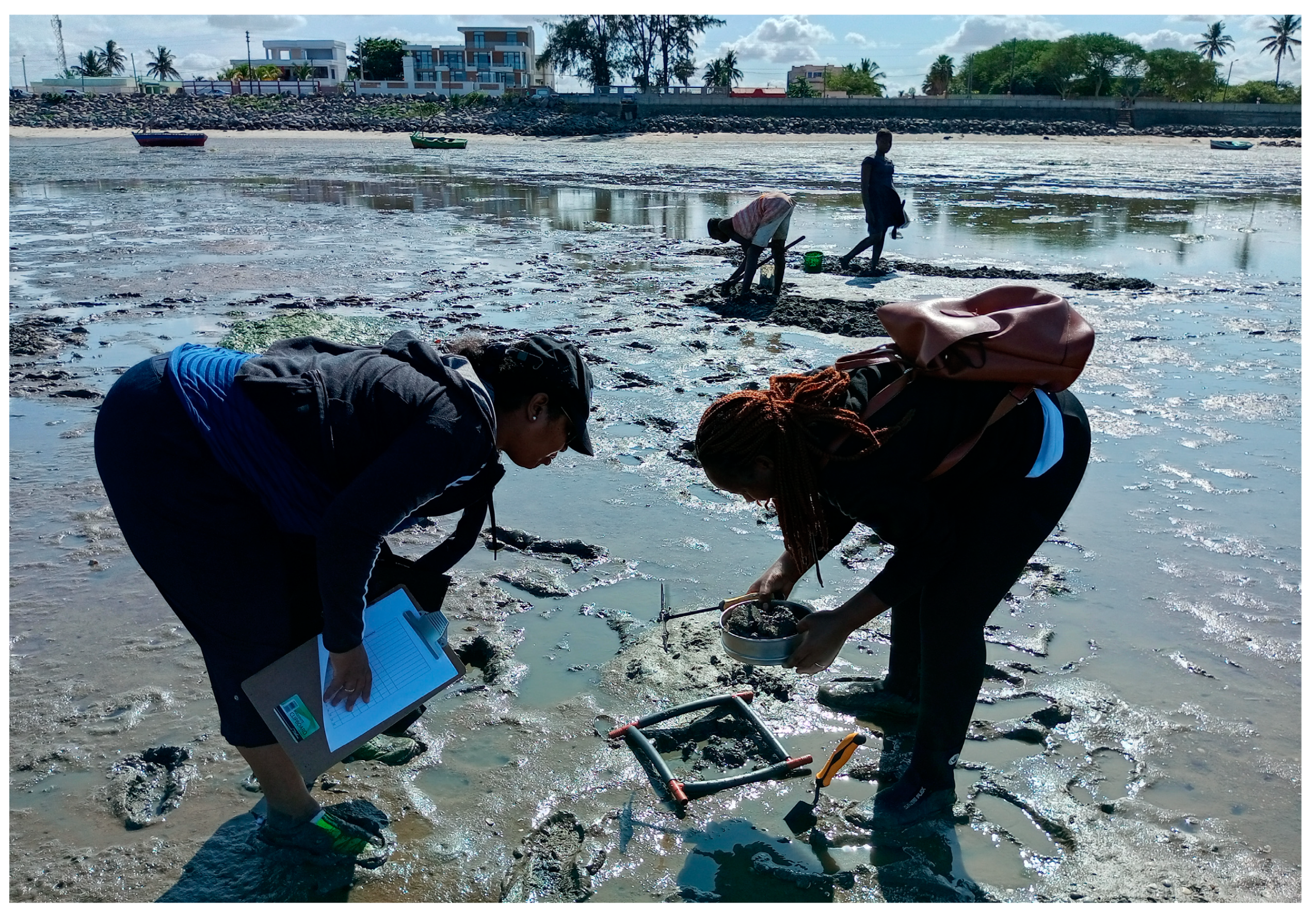

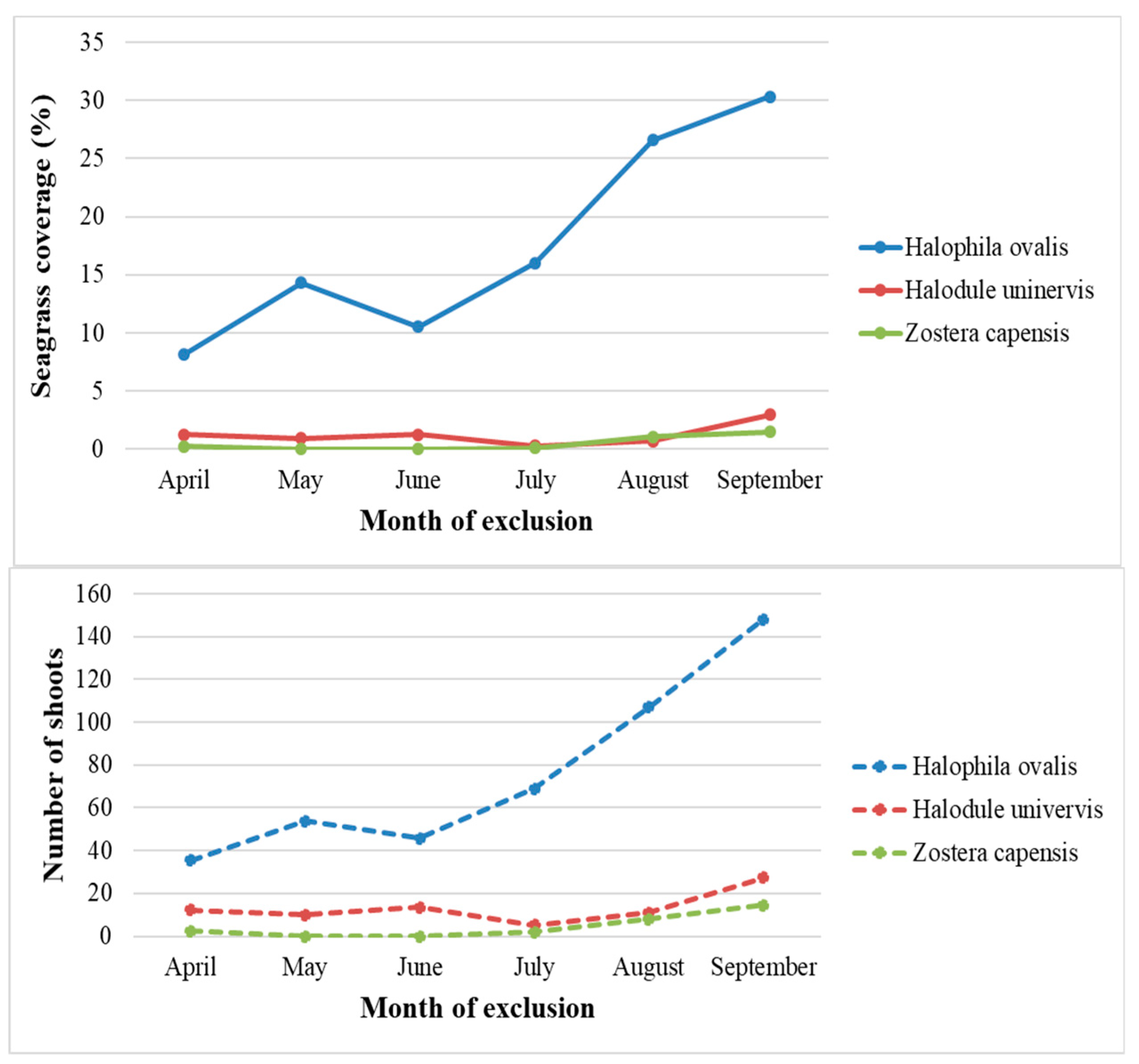
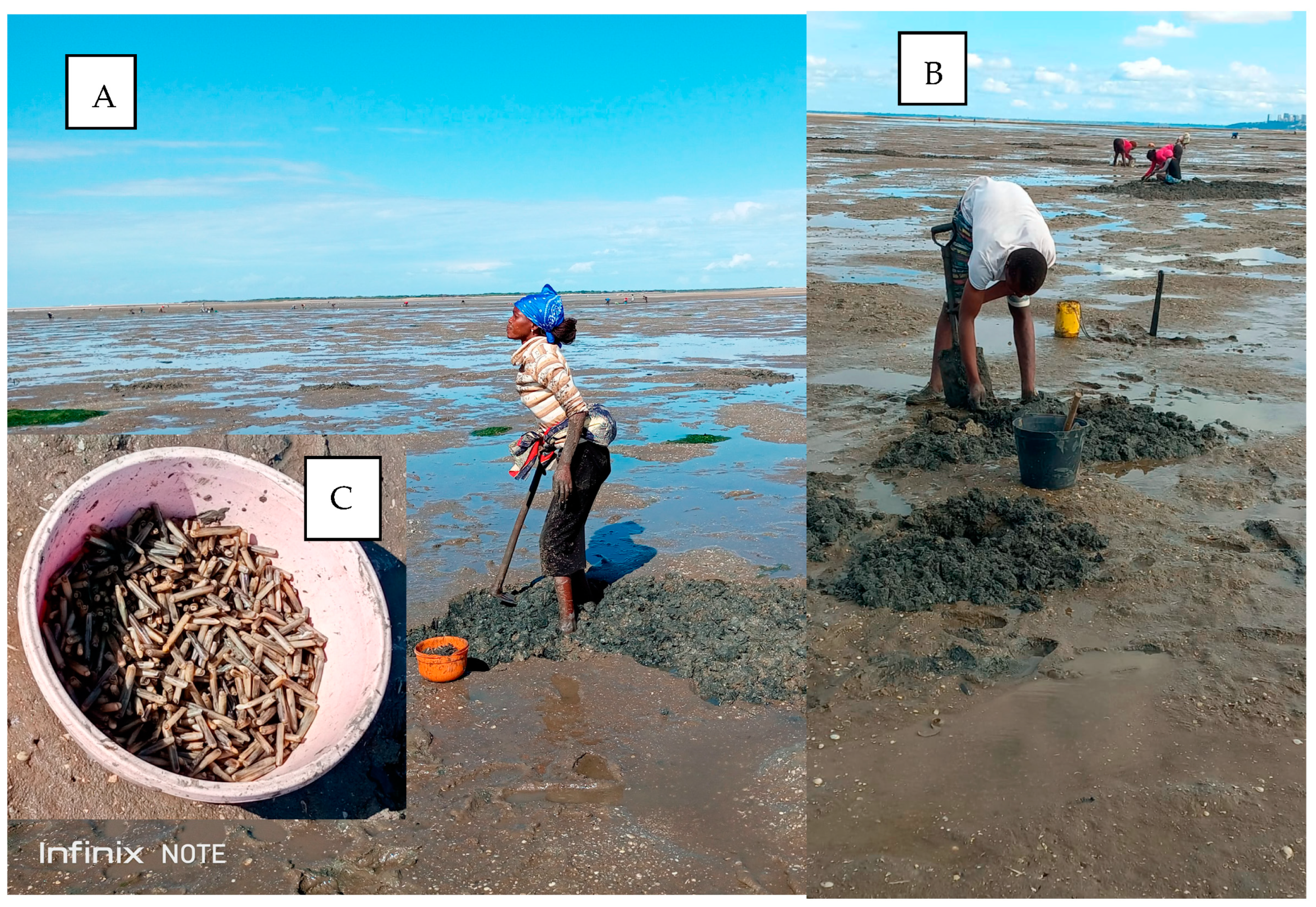
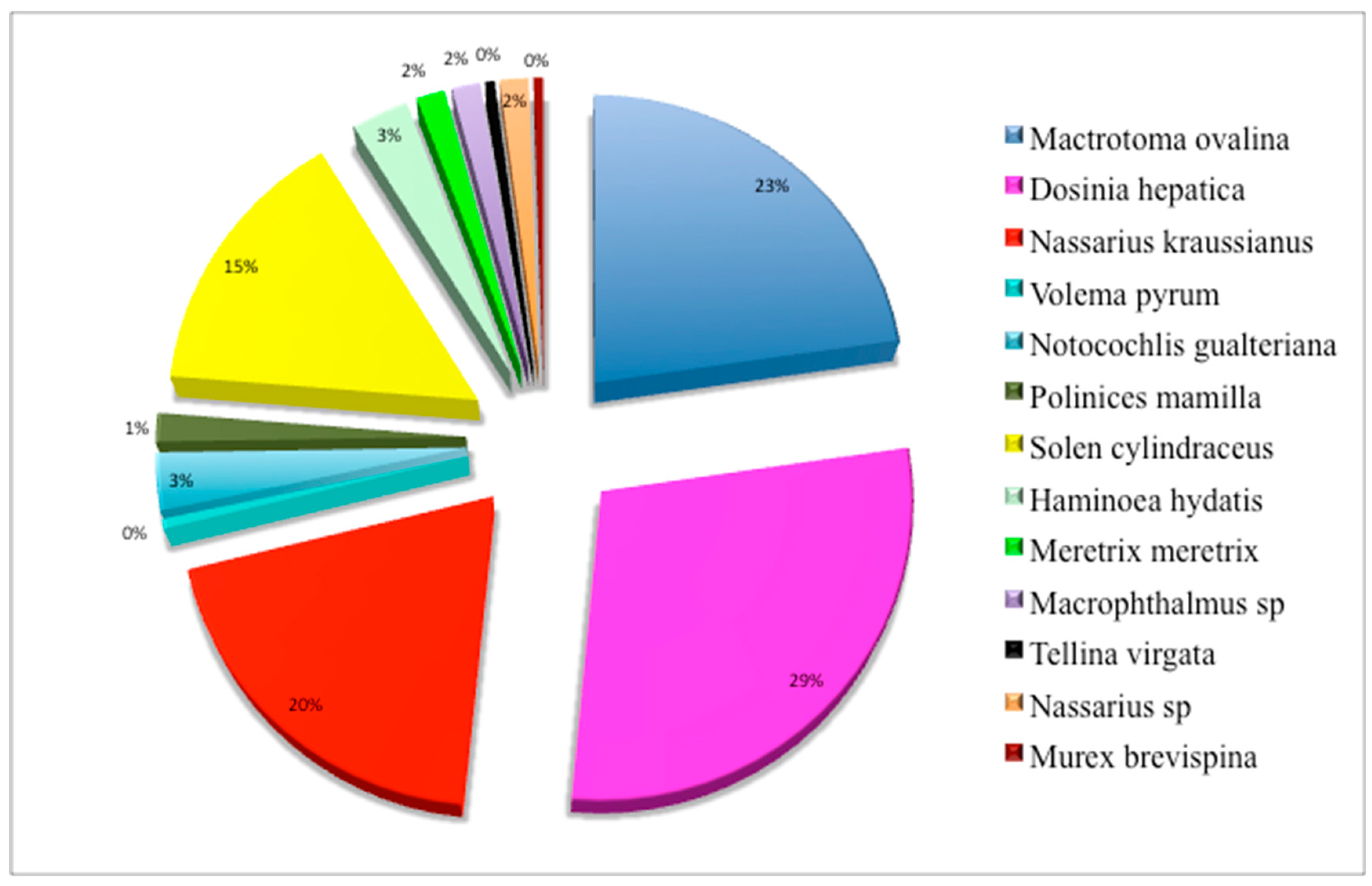
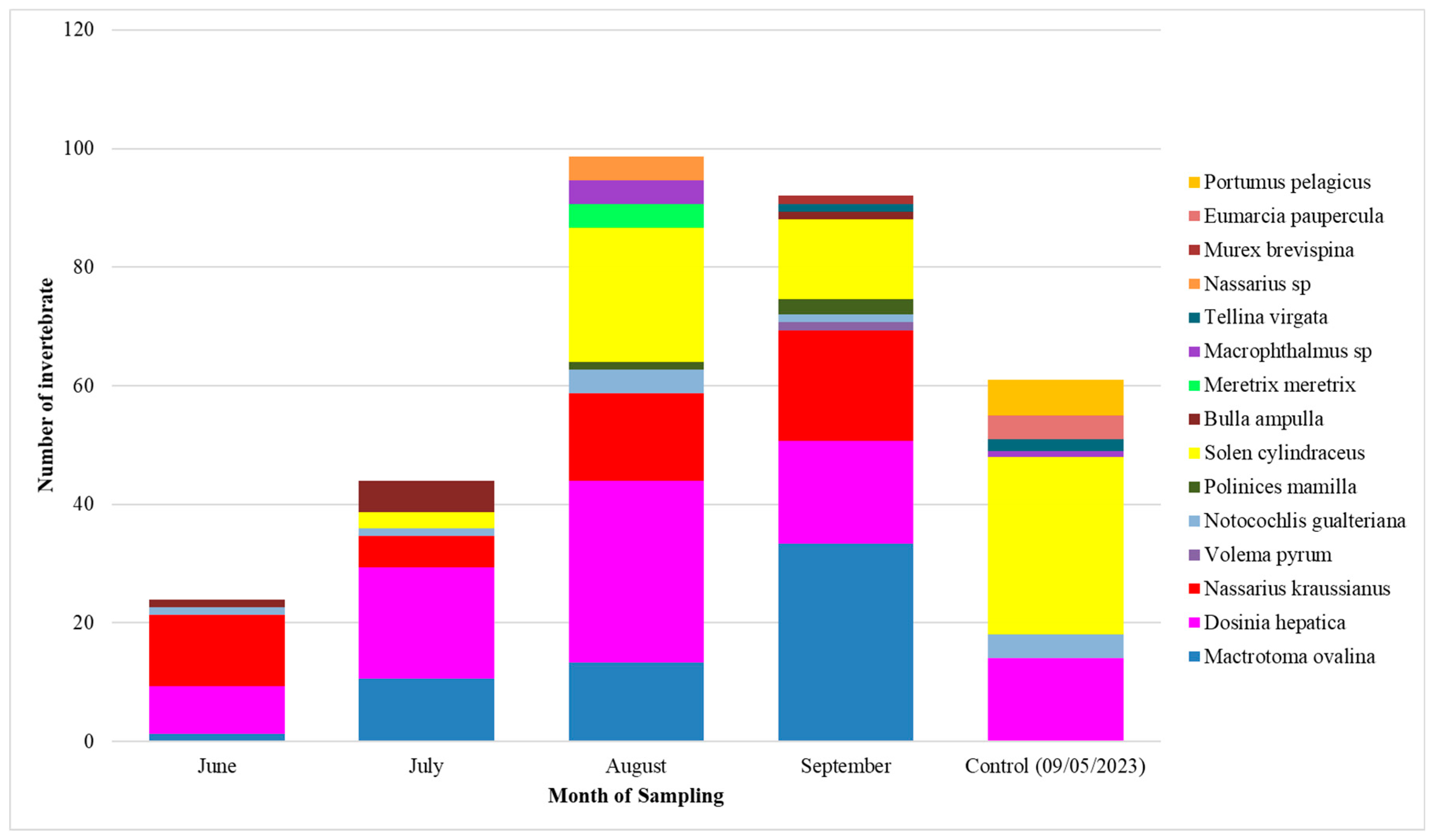
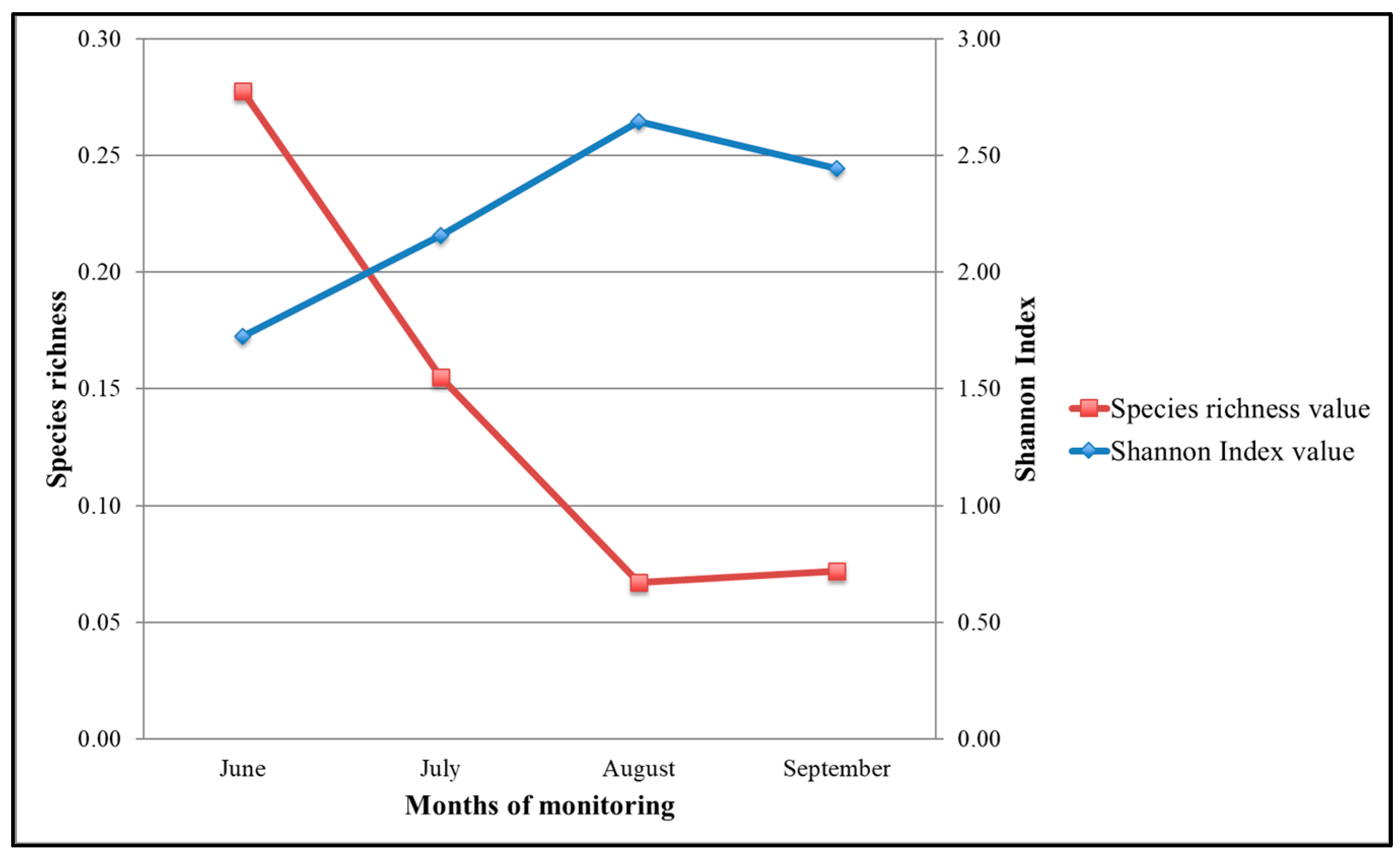
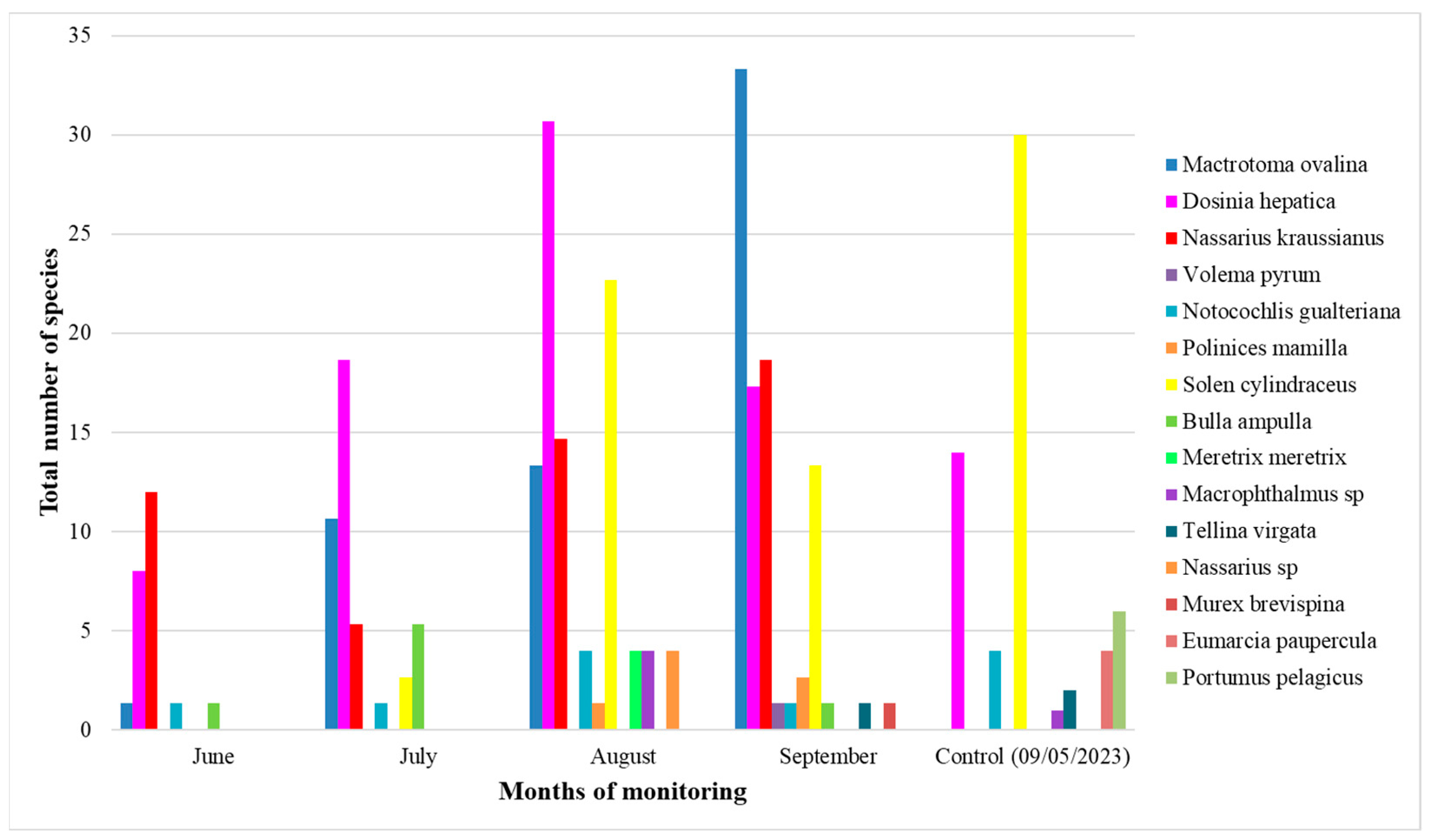

| Variables | Methods | |
|---|---|---|
| Gleaning | Level of exclusion | Qualitative description of each plot of exclusion (5 m × 5 m) focuses on violation signs, mainly human footprints, gardening hoe traces, removal of seagrass plants, removal of poles, and sedimentation. The variable was set between 5 and 0, where 0 represents the bad conditions of the plot, and 5 represents the best conditions. Each disturbance indicator present in the plot is accounted for to give the final score. The score of a plot was obtained after the subtraction of the disturbance value from 5, the maximum level score of an exclusion plot. Each score corresponds to a class: Excellent–Good–Medium–Low–Very low. |
| Seagrass | Density | In situ direct shoot counting within 3 subsamples of 0.25 m × 0.25 m selected randomly inside of plots of exclusion. |
| Coverage | In situ species coverage estimations were done under a subsample of 0.25 m × 0.25 m quadrats placed randomly inside exclusion plots. | |
| Invertebrate | Density | Number of species per unit area estimated from individual collected species within 3 sets of subsamples per exclusion plots. Sieve of 0.25 mm mesh size was used. |
| Richness | Diversity index calculated with Menhinick’s index. | |
| Shannon Index | Index combining density and richness calculated using the formula shown below. |
| Mean | SD | SE | 95% C.I. Difference | T | df | Sig. (2-Tailed) | ||
|---|---|---|---|---|---|---|---|---|
| Lower | Upper | |||||||
| April–May | −5.59 | 21.55 | 4.59 | −15.15 | 3.96 | −1.22 | 21 | 0.237 |
| April–June | −5.68 | 18.35 | 3.91 | −13.82 | 2.45 | −1.45 | 21 | 0.161 |
| April–July | −7.59 | 19.05 | 4.06 | −16.04 | 0.85 | −1.87 | 21 | 0.076 |
| April–Aug | −20.68 | 35.12 | 7.49 | −36.25 | −5.11 | −2.76 | 21 | 0.012 * |
| April–Sept | −37.86 | 45.69 | 9.74 | −58.12 | −17.61 | −3.89 | 21 | 0.001 * |
| Variable | HO | HU | ZC | S | |
|---|---|---|---|---|---|
| HO | Pearson Correlation | 1 | |||
| Sig. (2-tailed) | - | ||||
| HU | Pearson Correlation | 0.688 | 1 | ||
| Sig. (2-tailed) | 0.13 | - | |||
| ZC | Pearson Correlation | 0.951 ** | 0.792 | 1 | |
| Sig. (2-tailed) | 0.004 | 0.06 | - | ||
| S | Pearson Correlation | 0.992 ** | 0.77 | 0.973 ** | 1 |
| Sig. (2-tailed) | 0 | 0.073 | 0.001 | - |
| Mean | SD | SE | 95% C.I. Difference | T | df | Sig. (2-Tailed) | ||
|---|---|---|---|---|---|---|---|---|
| Lower | Upper | |||||||
| April–May | −4.77 | 19.15 | 4.08 | −13.26 | 3.72 | −1.17 | 21 | 0.255 |
| April–June | −2.91 | 14.60 | 3.11 | −9.38 | 3.57 | −0.93 | 21 | 0.361 |
| April–July | −7.55 | 15.60 | 3.33 | −14.46 | −0.63 | −2.27 | 21 | 0.034 * |
| April–Aug | −17.68 | 28.85 | 6.15 | −30.47 | −4.89 | −2.88 | 21 | 0.009 * |
| April–Sept | −28.82 | 41.63 | 8.88 | −47.28 | −10.36 | −3.25 | 21 | 0.004 * |
| Mean | SD | SE | 95% C.I. Difference | T | df | Sig. (2-Tailed) | ||
|---|---|---|---|---|---|---|---|---|
| Lower | Upper | |||||||
| April–May | −1.86 | 4.35 | 0.93 | −3.79 | 0.06 | −2.01 | 21 | 0.057 |
| April–June | −3.82 | 8.24 | 1.76 | −7.47 | −0.17 | −2.17 | 21 | 0.041 * |
| April–July | −0.68 | 3.17 | 0.68 | −2.09 | 0.72 | −1.01 | 21 | 0.324 |
| April–Aug | −2.14 | 5.47 | 1.17 | −4.56 | 0.29 | −1.83 | 21 | 0.081 |
| April–Sept | −6.45 | 9.55 | 2.04 | −10.69 | −2.22 | −3.17 | 21 | 0.005 * |
| Mean | SD | SE | 95% C.I. Difference | T | df | Sig. (2-Tailed) | ||
|---|---|---|---|---|---|---|---|---|
| Lower | Upper | |||||||
| April–May | 1.05 | 4.90 | 1.05 | −1.13 | 3.22 | 1.00 | 21 | 0.329 |
| April–June | 1.05 | 4.90 | 1.05 | −1.13 | 3.22 | 1.00 | 21 | 0.329 |
| April–July | 0.64 | 4.79 | 1.02 | −1.49 | 2.76 | 0.62 | 21 | 0.540 |
| April–Aug | −0.86 | 7.56 | 1.61 | −4.21 | 2.49 | −0.54 | 21 | 0.597 |
| April–Sept | −2.59 | 8.51 | 1.82 | −6.37 | 1.18 | −1.43 | 21 | 0.168 |
| Species (Edible Species with E Annotation) | June (ind/m2) | July (ind/m2) | August (ind/m2) | September (ind/m2) |
|---|---|---|---|---|
| Mactrotoma ovalina | 1 * | 11 + | 13 + | 33 ++ |
| Dosinia hepatica | 8 * | 19+ | 31 ++ | 17 + |
| Nassarius kraussianus | 12 + | 5 | 15 + | 19 + |
| Volema pyrum E | 0 − | 0 − | 0 − | 1 * |
| Notocochlis gualteriana | 1 * | 1 * | 4 * | 1 * |
| Polinices mamilla E | 0 − | 0 − | 1 * | 3 * |
| Solen cylindraceus E | 0 − | 3 * | 23 ++ | 13 + |
| Haminoea hydatis | 1 * | 5 * | 0 − | 1 * |
| Meretrix meretrix E | 0 − | 0 − | 4 * | 1 * |
| Macrophthalmus sp. | 0 − | 0 − | 4 * | 0 − |
| Tellina virgata | 0 − | 0 − | 0 − | 1 * |
| Nassarius sp. | 0 − | 0 − | 0 − | 4 * |
| Murex brevispina | 0 − | 0 − | 0 − | 1 * |
| Variable | MO | DH | NK | SC | TD | |
|---|---|---|---|---|---|---|
| MO | Pearson Correlation | 1 | ||||
| Sig. (2-tailed) | - | |||||
| DH | Pearson Correlation | 0.59 | 1 | |||
| Sig. (2-tailed) | 0.22 | - | ||||
| NK | Pearson Correlation | 0.77 | 0.701 | 1 | ||
| Sig. (2-tailed) | 0.07 | 0.12 | - | |||
| SC | Pearson Correlation | 0.63 | 0.87 * | 0.72 | 1 | |
| Sig. (2-tailed) | 0.18 | 0.02 | 0.11 | - | ||
| TD | Pearson Correlation | 0.83 * | 0.91 * | 0.88 * | 0.92 ** | 1 |
| Sig. (2-tailed) | 0.041 | 0.01 | 0.02 | 0.009 | - |
| Variable | EI | NEI | S | C | |
|---|---|---|---|---|---|
| EI | Pearson Correlation | 1 | |||
| Sig. (2-tailed) | - | ||||
| NEI | Pearson Correlation | 0.85 * | 1 | ||
| Sig. (2-tailed) | 0.029 | - | |||
| S | Pearson Correlation | 0.95 ** | 0.715 | 1 | |
| Sig. (2-tailed) | 0.004 | 0.11 | - | ||
| C | Pearson Correlation | 0.97 ** | 0.769 | 0.979 ** | 1 |
| Sig. (2-tailed) | 0.001 | 0.074 | 0.001 | - |
Disclaimer/Publisher’s Note: The statements, opinions and data contained in all publications are solely those of the individual author(s) and contributor(s) and not of MDPI and/or the editor(s). MDPI and/or the editor(s) disclaim responsibility for any injury to people or property resulting from any ideas, methods, instructions or products referred to in the content. |
© 2023 by the authors. Licensee MDPI, Basel, Switzerland. This article is an open access article distributed under the terms and conditions of the Creative Commons Attribution (CC BY) license (https://creativecommons.org/licenses/by/4.0/).
Share and Cite
Fanoro, T.F.-R.; Scarlet, M.P.; Bandeira, S.O. Intertidal Gleaning Exclusion as a Trigger for Seagrass Species and Fauna Recovery and Passive Seagrass Rehabilitation. Diversity 2023, 15, 772. https://doi.org/10.3390/d15060772
Fanoro TF-R, Scarlet MP, Bandeira SO. Intertidal Gleaning Exclusion as a Trigger for Seagrass Species and Fauna Recovery and Passive Seagrass Rehabilitation. Diversity. 2023; 15(6):772. https://doi.org/10.3390/d15060772
Chicago/Turabian StyleFanoro, Tsiaranto Felan-Ratsimba, Maria Perpétua Scarlet, and Salomão Olinda Bandeira. 2023. "Intertidal Gleaning Exclusion as a Trigger for Seagrass Species and Fauna Recovery and Passive Seagrass Rehabilitation" Diversity 15, no. 6: 772. https://doi.org/10.3390/d15060772








